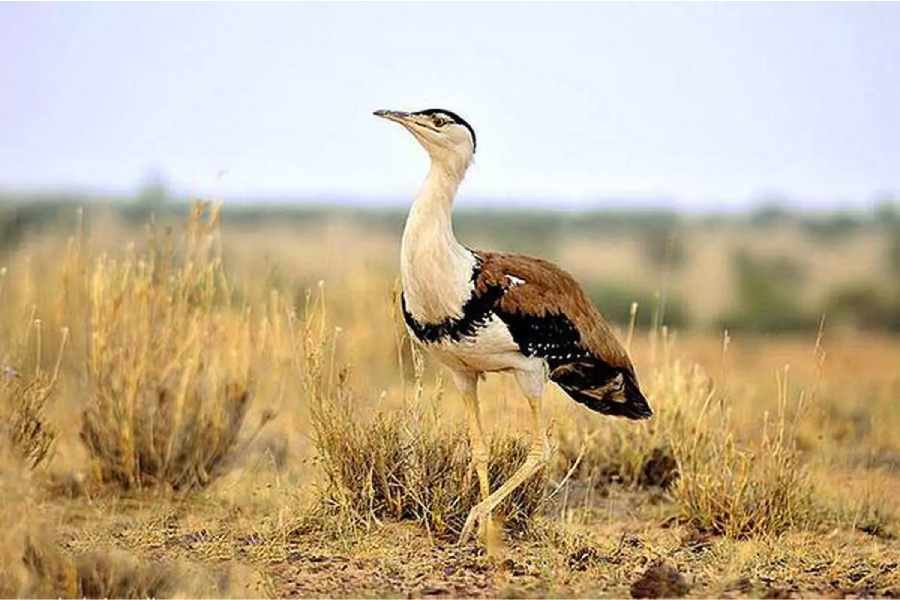Putting the ball in the Centre's court, the Supreme Court on Friday asked it to come out with a "comprehensive" plan to save the critically-endangered Great Indian Bustard while simultaneously keeping in mind India's international commitment on solar power.
The Great Indian Bustard (GIB) is especially found in Rajasthan and Gujarat and the alarming decrease in its numbers is attributed to their frequent collisions with "overhead transmission line", including those pertaining to solar power plants, criss-cross these areas.
The Great Indian Bustards have lateral vision as their eyes are on the sides of head and they find it difficult to change their flight course when confronted to a live wire.
According to the 2021 report of the International Union for Conservation of Nature (IUCN), the Great Indian Bustards are on the verge of extinction with hardly 50 to 249 of them alive.
"We want the Centre to tell us about the way forward. Otherwise, we will be groping in dark," said the bench comprising Chief Justice D Y Chandrachud and justices JB Pardiwala and Manoj Misra.
The top court also sought to know from the Centre as to whether there was any data based on scientific studies that these birds die of collision with the "overhead power transmission line".
"Do we have any authentic data from a government-monitored study on the efficacy of the bird diverters in saving the GIBs from collision-related deaths," the CJI asked, adding that now the Centre will have to decide the way forward as the apex court has already come out with its judgement.
"I am not sanguine about the bird diverters. What is the data with the Centre on the efficacy of bird diverters? We are asking the AG (attorney general) about the way forward. Tell us what can be done," the bench observed.
"Let the government just tell us about the way forward. Let a comprehensive status report be filed showing both the need for preservation of GIB and also the need of the solar power plants operating keeping in mind India's commitment at the international level...," the bench said.
It referred to twin rival aspects of the matter, saying that one pertained to saving these birds and the other related to setting up of solar power plants which can be set up in states like Rajasthan and Gujarat, the key habitats of this endangered species.
The bench asked the Centre to file a comprehensive status report dealing with the twin aspects of the matter and the way forward and fixed the PIL for further hearing on February 9. The government was asked to share the report with the parties concerned three days before the next date of hearing.
The bench took note of the submissions of senior advocate Shyam Divan, appearing for PIL petitioner MK Ranjitsinh, a retired IAS officer and others, that the Great Indian Bustard is on the verge of extinction and the court's 2021 judgement has not been complied with.
Besides seeking a status report from a court-appointed expert committee, the bench also directed the chief secretaries of Rajasthan and Gujarat to file the latest report on the steps taken in the case.
The CJI asked Attorney General R Venkataramani to take personal efforts in getting the issues resolved.
The top court, in its 2021 judgement on the PIL, had passed a slew of directions to save the Great Indian Bustard.
It had earlier directed the governments of Gujarat and Rajasthan to replace overhead electric cables with underground power cables, wherever feasible, and install bird diverters in priority areas where the birds live.
It had also set up a three-member committee, comprising scientists Rahul Rawat, Sutirtha Dutta and Devesh Gadhavi, Deputy Director of Corbett Foundation, to assess the feasibility for laying of the high-voltage underground power line.
However, the experts and others objected to the underground laying of high power transmission lines on the grounds of its feasibility.
It had also sought reports from the chief secretaries of Rajasthan and Gujarat on installation of bird diverters in priority areas and assess the total length of transmission lines in the two states where under-grounding of electric wires have to be done to ensure the birds do not die of electrocution.
The PIL has sought the court's directions for an urgent emergency response plan to protect and ensure the recovery of the numbers of the endangered Great Indian Bustard and Lesser Florican.
Except for the headline, this story has not been edited by The Telegraph Online staff and has been published from a syndicated feed.











